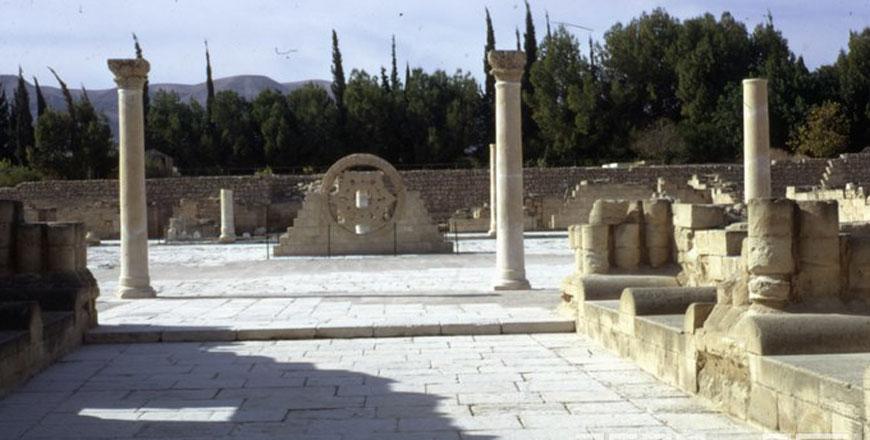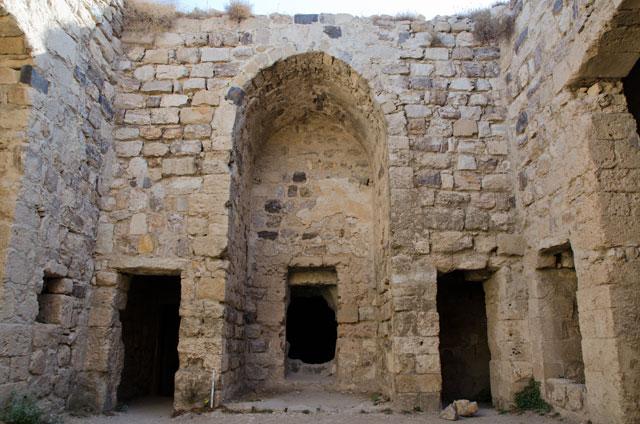You are here
Exploring Palestinian archaeology through Hisham’s palace in Jericho
By Saeb Rawashdeh - Jul 11,2024 - Last updated at Jul 11,2024

Stone rosette and columns at Umayyad Hisham’s Palace (Photo courtesy of ACOR)
AMMAN — Khirbet Mafjar or Hisham’s Palace in Jericho represents the Umayyad architecture and belongs to a list of desert castles that were built during the 8th century AD. There are three parts of the site — a palace, a bath and an agricultural estate, and all three structures were connected with a nearby springs by a sophisticated water system. The palace is known for its lavish decorations, mosaic carpets, human and animal figures, extensive stucco wall decoration and frescoes that make this monumental complex attractive to archaeologists and art historians.
The new studies highlighted the formal role of the palatine complex as previous researchers speculated that the Hisham Palace was a place only for private parties and banquets.
The recent research at the palace was conducted by the Palestinian Department of Antiquities and The University of Chicago.
“Dimitri Baramki had excavated a formal entrance, a typical Umayyad gate flanked by round towers, while south of the palace was the entrance from the south, leading to the town of Jericho, which was still an important focus of the entire oasis in the early Islamic period,” noted the scolar Andrew Creekmore from The University of Colorado, adding that the pavilion was in the centre of the garden between two gates.
North of the gate was a free-standing pavilion that Baramki called the “shaderwan”, since it stood in a shallow pool of water.
The audience hall is an important part of the palatine complex; castles in Karak, Ajloun, Shobak and Crac des Chevaliers in Syria have their audience halls.
“The palace with the Audience Hall was not a jumbled mass of buildings but an ordered garden with a long arcade looking east towards the fields, the Jordan River and highlands,” Creekmore continued, adding that an entire gate was revealed, with paving stones, iron plate and bands once adhered to the actual gate, and then ornate carved stones of an arch, once surmounted with crenellations.
“The gate also provided a transitional structure from the palace complex into what we called the Northern Area,” said the scholar Ignacio Arche who has been working for decades on the desert palaces.
This structure was speculated to be a way station or a quarter for servants.
“The earliest mosque in Jericho was in the Umayyad palace, excavated by Baramki. It was a standard design, placed between the palace and Audience Hall, with a private entrance for the Caliph from behind the mihrab or prayer niche.
Within the palace, Baramki had found another large mihrab in a narrow room flanked by four similar rooms,” Creekmore said, adding that Baramki thought this was a curious private prayer room.
The architectural archaeologist found this interpretation quite unacceptable.
Arche noted the disproportionately large mihrab, the exterior doorway, and the fact that partition walls were not attached to the north or south walls.
“Demonstrating his hypothesis, Arche stated that there should be column bases, and that the importance of this discovery is two-fold: The mosque was an important part of the original palace, occupying one quarter of the ground floor.
Moreover, the palace was not incomplete, as suggested by Hamilton, but had undergone significant structural changes during its Umayyad occupation,” Creekmore underscored.
Related Articles
AMMAN — Since research about the site was published in the 1950s, an Ummayad palace near Jericho has attracted historians of Islamic a
AMMAN — In 1189, after the victorious siege which started in 1187 and the crusaders’ fall of Hatting, Saladin came into possession of the ca
AMMAN – Raymond Bondin is a staunch advocate for heritage preservation with a career dedicated to safeguarding cultural sites in confl
















